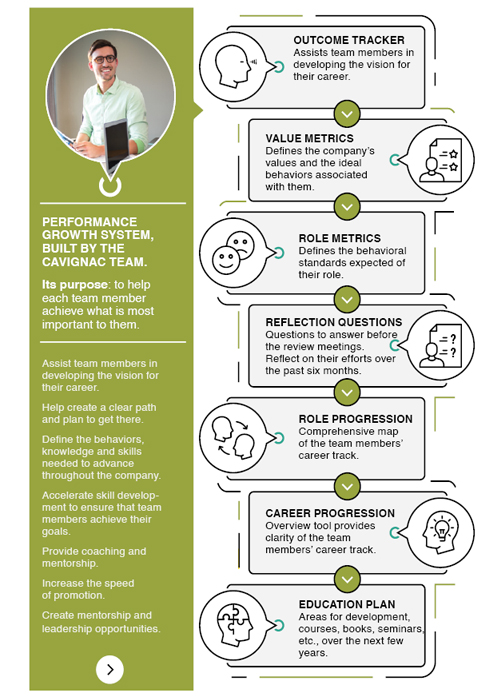Investment in recruitment, retention of top talent helps team members achieve what is important both professionally and personally
By Blake Cavignac
Employers have many responsibilities. One is to create an environment that encourages team member development—then rewards professional growth.
There are a few reasons for this.
The first involves recruiting.
During the interview process, the true motives behind why candidates are looking to make a move must be understood. A common theme involves some aspect of their wanting to work for a company that invests in their professional development, along with being provided a clear and attractive career path.
The second is retention. One need of today’s professionals is being provided with opportunities to experience consistent growth and advancement. Growth and advancement drive fulfillment. Fulfillment, specifically regarding one’s current and future role, drives retention.
The third relates to culture. When team-member development is supported and then backed by management rewarding growth, it tends to attract and retain the highest caliber of industry professionals. In doing so, the standards of behavior and performance increase, which then elevates the quality of company culture.
These are just a few reasons why it’s important to make consistent investments in educational and growth offerings, some of which may involve creating new programs that support the development and advancement of the team.
One way we did this back in 2021 was with the Performance Growth System (PGS), a program built by the Cavignac team. Its purpose: to help each team member achieve what is most important to them, both in their careers and in their lives.
To accomplish this, we designed the PGS to:
- Assist team members in developing the vision for their career.
- Create a clear path and plan on how to get there.
- Define the behaviors, knowledge and skills needed to advance from role to role throughout the company.
- Accelerate skill development to ensure that team members achieve their goals.
- Provide the coaching and mentorship to support these efforts.
- Increase the speed of promotion from role to role.
- Create mentorship and leadership opportunities for those interested.
Development, testing and launch
It took several months to develop the program. Once built, the focus turned towards implementation. This started with the Beta. More specifically, the PGS was implemented with select teams before launching it companywide. These teams played a vital role in its development.
Feedback during this phase was positive, with comments like: “I truly think this can really help employees analyze how they are currently doing and where they want to be in the future,” “I think it has been really helpful to see my personal vision and career vision mapped out in one place,” and, “Overall, there is a significant improvement in the team relationship dynamics, communications and morale.”
Throughout the Beta, we also learned more about the needs and desires of our team members. In addition, we identified areas for improvement and made the enhancements necessary to ensure that the PGS would accommodate them.
From there, the focus turned to the companywide launch. Like the Beta, we developed a set of procedures to guide the implementation. These consisted of specific steps that must be completed for a successful rollout: compiling a library of resources for team members to access to assist them in the development, creating guides for meetings with the managers and their team members who enrolled in the program, providing additional tools to support follow-up monthly pulse and biannual review meetings throughout the year and more.
Next, we met with each of the managers and their team members to take them through the introductory phase of the program—the core of which focused on the PGS Tracker, a development resource that consists of several tools and exercises. Some of these include:
Outcome tracker. Assists team members in developing the vision for their career. It then details the plan on how to make it a reality by establishing weekly, monthly and annual outcomes.
Value metrics. Define the company’s values and the ideal behaviors associated with them. Team members then do self-assessments throughout the year to ensure that their behaviors are in alignment.
Role metrics. Define the behavioral standards expected of their role. Like the value metrics, team members then do self-assessments throughout the year to ensure that they’re being met.
Reflection questions. A set of questions that are completed before the review meetings. Their purpose is to help each team member reflect on their efforts over the past six months, identify areas for improvement, recognize successes, and stay on track towards achieving their outcomes and vision.
Role progression. A comprehensive map of the team members’ career track. Part of this details what must be accomplished to advance and be promoted to the next role within that track.
Career progression. An overview of the role progression tool. This simplifies and provides additional clarity of the team members’ career track.
Education plan. Outlines the areas of development, courses to be taken, books that will be read, seminars that will be attended, etc., over the next few years. All of this is done to ensure that the team member is experiencing consistent growth while staying on track towards achieving their objectives.
This phase required a couple of meetings with the manager and the manager’s team members to get them enrolled in the PGS, the last of which finalizes the team members’ vision and outcomes along with their career path and education plan.

Growth and advancement drive
fulfillment. Fulfillment, specifically
regarding one’s current and future
role, drives retention.
Management leads
After that, the manager takes the lead, and it becomes their responsibility to meet with their team members (once a week to once a month) for their pulse meetings. These meetings provide the manager with an opportunity to check in to see how each team member is progressing on their outcomes and provide guidance when necessary. It’s also a time for managers to identify ways in which they can better support employee growth efforts.
After these meetings, the manager or team member then sends a recap email detailing what was discussed. They’ll conclude the email by sending agreed-upon action items that will be completed before the next pulse meeting.
Aside from the pulse meetings, we also incorporate biannual review meetings, taking place in June and December. Their purpose is to provide team members with an opportunity to self-assess their performance over the previous six months. It’s also a time for the manager and team member to assess areas for improvement, recognize accomplishments, identify how management can better support team members and ensure that the team member is on track towards achieving what is most important to them in their careers.

The team members who use this system to its potential have seen strong results both in their professional and personal lives. This is what one colleague had to say about the Performance Growth System: “I have grown more in my career in the last five months through the Performance Growth System than I could have imagined. I’ve also learned more in the past five months than I did in my previous role, where I spent over three years. This program has set a foundation I can build upon in both my personal and professional life while giving me the confidence to continue to challenge myself in my current role and any future responsibilities I take on.”
The Performance Growth System is proving to be more than a development tool. For one, it has now become a vital element in our recruitment process. When walking candidates through it, they tell us that it’s a differentiator—a program unlike any other they’ve been offered or seen. It’s also proving to be an effective tool that assists with manager development.
Another benefit is the number of team member promotions we’ve seen in the past two years. We also experience all the benefits that come with team members taking a proactive and consistent approach towards their education, skill development and career growth.
We’re now a couple of years into the program. The PGS continues to prove its value. It requires a significant investment of time, effort and commitment, but it’s an investment we’ll always continue to make due to the positive impact we’ve seen in team member development along with the results being experienced within recruitment, retention and culture.
The author
Blake Cavignac is the growth advisor at Cavignac. To learn more about the company, visit www.cavignac.com.






